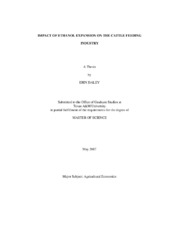| dc.description.abstract | The U.S. has a history of producing surplus corn, but the current and projected growth
in ethanol production combined with strong feed and export demand is causing an
overall increase in corn utilization. Although livestock feeders are projected to remain
the largest users of corn, corn utilization can be reduced if ethanol co-products are used
to replace a portion of corn in finishing rations.
The objective of this study was to determine the economic trade-offs for cattle
feeders when facing higher corn prices and increasing supplies of ethanol co-products.
A stochastic partial budget model was used to determine the impact on the cost of gain
when ethanol co-products are substituted into rations at varying inclusion rates. The
model was built for all four major cattle feeding states: Texas, Nebraska, Kansas, and
Colorado. Ration scenarios were developed for each state, based on the research
results of feedlot nutrition and personal communication with feedlot operators. The
various scenarios were simulated to determine the impacts of changing corn prices,
corn processing costs, cattle performance, and feeding and transportation costs for Wet
Distiller’s Grains with Solubles (WDGS) on the key output variable, cost of gain.
The model results indicated when 15 percent WDGS (on a dry matter basis)
replaces a portion of corn and protein supplement, the simulated cost of gain is lower than the base ration scenario when the feedlot is located within 200 miles of ethanol
production. When feedlots are located more than 200 miles from an ethanol plant,
Dried Distiller’s Grains with Solubles (DDGS) can be fed to lower the cost of gain;
therefore, ethanol co-products can be fed to help offset potential increases in corn
prices.
The partial budget model is a useful tool for livestock, corn, and ethanol
producers who are attempting to determine the impacts of ethanol expansion on corn
price and utilization. Policy makers can also benefit from the model analysis as they
face decisions in the future regarding ethanol and farm policy alternatives. | en |


